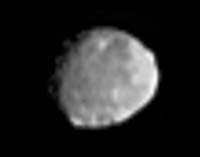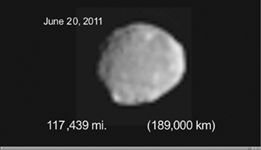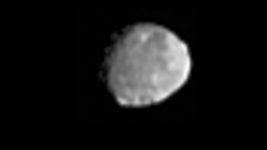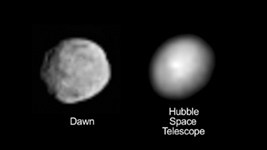|
COMETS EARTH JUPITER KUIPER BELT MARS MERCURY METEORITES NEPTUNE OORT CLOUD PLUTO SATURN SOLAR SYSTEM SPACE SUN URANUS VENUS ORDER PRINTS
PHOTO CATEGORIES SCIENCEVIEWS AMERICAN INDIAN AMPHIBIANS BIRDS BUGS FINE ART FOSSILS THE ISLANDS HISTORICAL PHOTOS MAMMALS OTHER PARKS PLANTS RELIGIOUS REPTILES SCIENCEVIEWS PRINTS
|
Related Documents
Download Options
This movie and set of still pictures show images obtained by NASA's Dawn spacecraft on its approach to the protoplanet Vesta and a comparison of views from Dawn's framing camera and NASA's Hubble Space Telescope. The first part of the video shows nine sets of images obtained for navigation purposes by Dawn's framing camera. Each set includes 20 frames. Each of the first five sets covers 30 minutes in duration. Each of the last four sets covers 60 minutes in duration. The first set was taken on May 3, 2011, the start of the spacecraft's approach to Vesta. The other sets were obtained on May 10, May 17, May 24, June 1, June 8, June 14, June 17 and June 20, 2011. In the second part of the video, images from Dawn appear on the left and images from Hubble appear on the right. Dawn's images of Vesta are a little more than twice as sharp as Hubble's. Images from Hubble, which is in orbit around the Earth, were obtained on May 14 and 16, 2007, when Vesta was 109 million miles (176 million kilometers) away from Earth. Dawn's images were taken on June 20, 2011, when Dawn was about 117,000 miles (189,000 kilometers) away from Vesta. One still image (Figure 1) shows Dawn's view of Vesta from June 20, 2011, when the approaching spacecraft was about 117,000 miles (189,000 kilometers) away from the body. The other still image (Figure 2) shows a comparison of views of Vesta obtained by Dawn (left) and Hubble (right). The image from Dawn is a little more than twice as sharp as the image from Hubble. The image from Hubble, which is in orbit around the Earth, was obtained on May 14, 2007, when Vesta was 109 million miles (176 million kilometers) away from Earth. Vesta is the second-most massive object in the main asteroid belt. Vesta is expected to capture the spacecraft into its orbit on July 16. Official science gathering begins in early August. The Dawn mission is managed by NASA's Jet Propulsion Laboratory in Pasadena, Calif., for the agency's Science Mission Directorate in Washington. Dawn is a project of the directorate's Discovery Program, managed by NASA's Marshall Space Flight Center in Huntsville, Ala. UCLA is responsible for overall Dawn mission science. Orbital Sciences Corp. of Dulles, Va., designed and built the Dawn spacecraft. The framing cameras were developed and built under the leadership of the Max Planck Institute for Solar System Research in Katlenburg-Lindau, Germany. The German Aerospace Center (DLR) Institute of Planetary Research in Berlin made significant contributions in coordination with the Institute of Computer and Communication Network Engineering in Braunschweig. The framing camera project is funded by the Max Planck Society, DLR and NASA. JPL is a division of the California Institute of Technology in Pasadena. |



